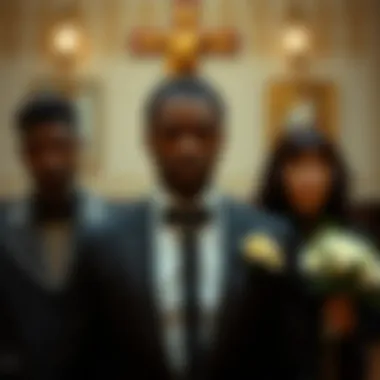Exploring Black Formal Attire for Funerals


Intro
The significance of black in funeral fashion isn't just a matter of tradition; it relates directly to how individuals express their own identity amid a backdrop that often calls for restraint. This article seeks to unravel the layers of meaning behind this dress code while providing a practical guide tailored not only to fulfill societal expectations but also to allow for personal expression within the sometimes rigid confines of formality.
We'll break down the nuances of appropriate attire, highlight key fashion trends, and uncover essential wardrobe pieces that can serve you well in these somber occasions. By blending contemporary styles with historical insights, readers will be prepared to choose outfits that reflect both respect and personal flair. Let's dive in.
The Significance of Color in Funeral Attire
The choice of color for funeral attire is not just a matter of personal preference; it carries deep cultural and emotional significance. In many societies, colors communicate messages that go beyond the surface. This section sheds light on why black is often the primary choice for such solemn occasions but also explores other colors and the meanings they hold. Understanding these aspects helps attendees honor the wishes of the deceased and their family while also navigating the complexities of their own expressions of grief.
Historical Context of Black in Memorial Services
Black's association with mourning can be traced back to ancient civilizations. In Western culture, the color black has long been viewed as a symbol of loss and sorrow. One notable reference is from the Roman Empire, where mourners adorned themselves in dark attire as a sign of respect and grief during funerals. This practice established an enduring legacy that reverberated through the ages.
In the 19th century, the Victorian era further solidified black as the color of mourning, with elaborate mourning rituals and specific dress codes emerging. Women often wore full black dresses accompanied by veils, while men donned dark suits, emphasizing the gravity of the occasion. The choice of black became institutionalized, morphing into a standard expectation at funerals, reinforcing the dual role of color as a symbol of grief and respect.
However, the historical context reveals other colors were also employed at times. White, which is often linked to purity and new beginnings, was worn in some cultures, such as in parts of East Asia. The duality of these color choices feeds into discussions of how modern interpretations might shift with changing societal values.
Cultural Variations and Their Influence
Cultural perspectives on funeral colors can greatly differ. While black is prevalent in many Western contexts, other societies interpret colors in varied ways. For example, in China, white attire signifies mourning, contrasting the Western norm. This divergence influences how individuals approach the color choices for funeral dress, emphasizing the importance of being aware of the family's cultural background.
In African cultures, colors like red can represent both mourning and celebration, reflecting the understanding that death is part of a cycle. Similarly, in India, the color white is worn by mourners, making it a staple for those grieving the loss of loved ones.
This multilayered understanding of color in funeral attire not only celebrates the diverse cultural practices but also reinforces the individuality of the grieving process. Individuals attending a funeral may feel drawn to specific colors that resonate with their personal experiences or familial connections, adding a layer of subjective meaning to their attire choices.
"In the end, understanding the significance of colors in funeral attire is an essential part of honoring someone who has passed. It connects us to traditions and offers a way to express our sorrow."
By acknowledging these cultural variations, attendees can approach funerals with a sense of respect and awareness, mindful of the deeper meanings behind their color choices. Navigating this complex landscape of color can significantly influence how individuals experience and express their grief.
Understanding Formal Dress Codes
When it comes to funerals, understanding formal dress codes isn’t just about choosing the right outfit; it’s fundamentally tied to showing respect and honoring the deceased and their family. Attending a memorial service is a solemn occasion where emotions run deep, and the attire worn often communicates sentiments that words cannot express.
Funeral attire adheres to specific guidelines rooted in tradition, cultural values, and the preferences of families. In a way, it serves as a reflection of the collective grief and celebration of life. Thus, understanding what constitutes formal dress is imperative for attendees wishing to navigate these sensitive waters with grace.
Defining Formal Attire
So what exactly is considered formal attire? In the realm of funerals, formal suggests a polished, understated look that is decidedly more sophisticated than casual wear. A classic black suit often tops the list of appropriate choices for men, while women might lean toward elegant dresses or well-fitted suits. Elements such as fabric choice, fit, and accessories play significant roles in defining formal wear.
A black suit, for instance, should be tailored to one’s body, sending a message of reverence instead of distraction. Shirts are usually crisp and monochromatic; a traditional white fits the bill for men, while women often pair their dresses with subtle, muted hues.
Accessories should err on the side of subtlety: a simple tie or a delicate piece of jewelry can complement the look without drawing attention away from the occasion. In short, the essence of formal attire lies in its simplicity, elegance, and respectfulness.
Differences Between Formal, Semi-Formal, and Casual
Understanding the distinctions between formal, semi-formal, and casual attire is crucial for navigating funeral dress codes effectively. Here's a breakdown:
- Formal Attire: This is the highest standard of dressing. For men, it typically means a dark suit, a dress shirt, and a conservative tie. For women, it encompasses long or knee-length dresses that are usually in subdued colors. Think of it as what you’d wear to a wedding but without the flair.
- Semi-Formal Attire: Here, the level of formality relaxes a bit. Men might opt for dress slacks paired with a well-fitted blazer, and women could wear cocktail dresses or tailored pantsuits. In the context of funerals, this choice remains respectful but can allow for a tad more personal expression.
- Casual Attire: This is generally frowned upon in a funeral setting. It includes items like jeans, T-shirts, or sneakers, which can come off as disrespectful. While a more relaxed gathering may permit some leniency, it's still best to lean towards items that maintain a sense of solemnity—like chinos or nice trousers paired with a collared shirt.
In a world where dress codes can often feel like a maze, knowing the right path to take for each occasion—and in the case of funerals, understanding the nuances—is essential for showing support and honoring those who have passed.
Attire Options for Men
When attending a funeral, men often find themselves navigating the complex terrain of appropriate attire. The choices made in this solemn context are not merely about fashion or personal preference; they carry weighty implications, reflecting respect for the deceased and their family. Understanding attire options for men is crucial in striking a balance between tradition and individual expression. Choosing the right outfit contributes to an atmosphere of dignity while allowing the wearer to feel comfortable and confident.
Classic Black Suit: Key Elements
The classic black suit remains a cornerstone of formal funeral wear for men. It's timeless, exuding an air of respect that aligns perfectly with the gravity of the occasion. When selecting a black suit, consider the following key elements:
- Fit: A well-fitted suit enhances overall appearance. Tailoring can make all the difference, allowing the wearer to feel at ease while looking polished.
- Fabric: Opt for fabrics like wool or a wool blend. These materials offer elegance and comfort, especially in varying weather conditions.
- Style: Single-breasted suits are generally preferred for their simplicity, but a double-breasted jacket can also work if styled carefully. The lapel style can also play into the overall aesthetic—peak lapels give a sharper look, while notched lapels might lend a more relaxed vibe.
Incorporating these elements not only honors the occasion but also aligns with the expectations of the gathering. A classic black suit acts as a silent tribute, demonstrating a commitment to the communal experience of mourning.
Shirts and Ties: Creating a Cohesive Look


Following the selection of a black suit, attention turns to shirts and ties, crucial components that can complete a respectful and cohesive look. The choices made here should echo the overarching theme of solemnity.
- Shirt Color: White is often the go-to choice; it embodies simplicity and cleanliness. Light grey or muted colors can add subtle variation without drawing attention away from the purpose of the event.
- Tie Choices: A conservative tie is ideal. Patterns should be avoided or kept minimal, and solid colors in darker shades often work best.
- Texture: Consider the fabric. A silk tie can give a touch of elegance, while woven cotton might offer a more approachable vibe. However, the focus must remain on the sentiment rather than the style.
The combination of shirt and tie should resonate with the overall look while maintaining an understated presence. The aim is to ensure that the individual is appropriately dressed, yet the focus can remain on honoring the departed.
Footwear Choices and Their Impact
Footwear is another aspect often overlooked when preparing for a funeral. However, the right shoes play an integral role in forming the overall impression.
- Dress Shoes: Black leather dress shoes are typically the best option. Styles can range from oxfords to loafers, but they should always look polished and well-kept.
- Comfort: While elegance is important, comfort is vital as funerals can often involve standing for long periods or walking long distances. A balance between style and comfort ensures that attendees can focus on the service rather than any discomfort from their attire.
- Cleanliness: It's imperative to ensure shoes are clean and polished. A scuffed pair can subtly convey a lack of respect, which can be entirely counterproductive in this setting.
Ultimately, footwear choices should reflect an understanding of the significance of the event. Their role may be understated, yet they contribute to the overall impression and respect shown to those grieving.
Attire Options for Women
When it comes to dressing appropriately for funerals, women have a variety of options that blend respect with personal expression. The attire selected not only reflects a somber respect for the deceased but also allows individuals to convey their own sense of style while adhering to traditional expectations. In this section, we will unpack some wardrobe choices that strike a balance between honoring the occasion and maintaining a personalized touch.
LBDs: The Timeless Little Black Dress
The Little Black Dress, often referred to as an LBD, is a staple in any woman’s wardrobe and shines particularly brightly in the context of funerals. This piece is not just a key element of fashion history but serves a greater purpose on these solemn occasions.
Why an LBD? One reason is its versatility; it can be styled in various ways depending on the individual’s personal flair and comfort level. An LBD might range from a simple, straight-cut design to something with elegant sleeves or embellishments. Regardless of the variation, its inherent simplicity allows for a respectful appearance.
"A well-chosen LBD can enhance dignity while offering comfort in the complexities of attending a funeral."
When selecting an LBD for a funeral, consider the fabric and cut. Heavier fabrics like wool blend or thick cotton provide a polished appearance while being practical across seasons. Opt for darker shades such as black or charcoal for that classic touch. It’s also important to keep to modest lengths—something at or below the knee tends to align with common expectations.
Long Dresses and Their Cultural Significance
Long dresses offer another powerful sartorial choice for women attending funerals. These dresses not only convey respect but also can carry deep cultural meaning based on a woman’s heritage or the nature of the memorial service itself.
Many cultures embrace long dresses as traditional funeral attire. For example, in certain Asian cultures, long flowing garments in dark hues signify mourning and formality. They symbolize sorrow and create a visual cohesion among attendees. Choosing a long dress can symbolize solidarity among the grieving community, especially if many attendees choose similar styles.
When opting for a long dress, consider the following:
- Color: While black is standard, other dark hues can be acceptable in some cultures, such as deep navy or dark green.
- Material: Lighter fabrics like chiffon or silk tend to work well in warmer climates, while heavier fabrics like velvet provide warmth in cooler settings.
- Fit: A well-fitted dress can allow movement and ease during the service, making comfort essential.
Accessorizing for Elegance Without Extravagance
Accessorizing can be a tricky path to navigate, especially in funeral settings where the goal is to maintain elegance without veering into theatricality. The key is to choose pieces that complement the outfit rather than overshadow it.
Consider these guidelines for accessorizing:
- Jewelry: Minimalistic jewelry such as stud earrings or a delicate bracelet can add a touch of grace without drawing attention away from the overall appearance.
- Scarves and Wraps: These can be both stylish and practical, providing modesty and warmth while enhancing the overall look. Choose muted tones or subtle patterns.
- Footwear: Opt for low-heeled shoes or flats, ensuring comfort as you may be standing for long periods. Closed-toe shoes tend to be more appropriate in formal settings.
By choosing accessories wisely, it’s possible to enhance your overall appearance while still remaining grounded and respectful of the occasion’s sentiment. Merging personal style with discretion is crucial in making thoughtful choices that honor both the deceased and their loved ones.
Attire Considerations for All Genders
When it comes to choosing attire for funerals, the considerations push beyond mere aesthetics. Attire plays a pivotal role in honoring the deceased and supporting the grieving family. It serves as a visual expression of respect that melds with the somber environment. Understanding these considerations can make a world of difference, ensuring that your choices balance personal style and sensitivity.
Fabric Choices for Different Seasons
Selecting the right fabric is essential in maintaining comfort while adhering to expectations around formal attire at funerals. During warmer months, lightweight fabrics such as linen or cotton can be quite effective. They allow moisture to escape easily, keeping the wearer cool without sacrificing decorum. Choosing dark colors in these materials still reflects the solemnity of the occasion. For colder months, heavier fabrics like wool or velvet not only provide warmth but also convey richness and gravitas.
Key Considerations for Fabric Selection:
- Breathability: Opt for breathable materials in hot weather to ensure comfort.
- Warmth: Choose thicker fabrics if attending a winter service to manage the chill.
- Texture: Matte fabrics, while preserving an elegant look, help maintain a respectful air.
"The weight and drape of the fabric can often convey unspoken messages about respect, care, and understanding of the occasion."
Layers and Their Role in Functionality
Layering is another crucial aspect to think about, as it can affect both functionality and appearance. Each layer serves a purpose, from temperature control to offering an added dimension to the outfit. For instance, a tailored black blazer can elevate a simple dress or a pair of slacks while helping manage variable indoor and outdoor temperatures. Furthermore, having layers allows one to adapt their appearance as conditions change throughout the day.


Tips for Effective Layering:
- Consider Outerwear: A long coat can maintain elegance while combating the cold.
- Choose Versatile Pieces: A shawl or wrap can add comfort without drawing too much attention.
- Mix Textures With Care: Delicate layers can enhance the overall look without detracting from the formal tone.
Overall, understanding the fabric and layering dynamics not only focuses on your physical comfort but also conveys to others a deeper respect for the mourning process and traditions tied to it.
Guidelines for Attire Selection
Selecting the right attire for a funeral is not just about covering oneself in dark colors; it speaks volumes about respect, empathy, and understanding of the circumstances surrounding the event. Guidelines for attire selection provide a framework that helps attendees navigate the nuances of social expectations while honoring the deceased and their family. By understanding these guidelines, individuals can effectively pay their respects without drawing unnecessary attention.
One of the key elements is recognizing that funerals are solemn occasions. The attire chosen should reflect the weight of the moment. Black clothing traditionally dominates these scenes, but there is an increasingly broad acceptance of other muted colors as well, depending on specific cultural or familial preferences. Thus, it's essential to consider the specific wishes conveyed by the family when planning what to wear.
An added benefit of adhering to attire guidelines is that it helps mitigate the risk of standing out inappropriately. By being cognizant of the established dress codes, attendees can ensure their presence is felt for the right reasons, showing solidarity with those in mourning rather than drawing attention to themselves.
Understanding the Family's Wishes
The first step in selecting appropriate funeral attire is understanding the family's wishes. Every family has its unique customs and traditions that dictate what is considered acceptable. Some families may strictly adhere to conventional all-black attire, while others might prefer a more relaxed approach.
When in doubt, direct communication is paramount. If you're close to the grieving family or the deceased, simply asking them about their preferences can go a long way in demonstrating your thoughtfulness. Writing down things they mention can also help, as it emphasizes that you value their feelings during this challenging time.
If one is not able to reach out directly, social media platforms like Facebook might provide insights into how the family has expressed their sentiments regarding dress codes. Funeral home announcements or obituaries sometimes include such details, allowing attendees to gather vital information.
Navigating Dress Code Requests
As social norms evolve, so too do funeral dress codes. It's increasingly common to see specific dress code requests mentioned in funeral announcements. Navigating these requests requires a mix of sensitivity and personal judgment.
- Formal: When a request for formal attire is made, this typically means suits, ties, or elegant dresses, firmly rooted in tradition. Attendees should always err on the side of caution, opting for more formal options if uncertain.
- Semi-Formal: This could mean a notch below full formal wear but still leaning towards comfortable, respectful options. Opting for tailored pieces in darker shades usually works.
- Casual Attire: In some cases, a family may designate a relaxed atmosphere, allowing for more personal expression even within what might seem like casual clothing. One might consider smart casual options like dark trousers paired with a subdued blouse or smart shirt that respect the occasion.
In navigating these requests, being adaptable yet respectful is the name of the game. Remember to set a standard that mirrors the solemnity of the occasion - it's often about harmonizing personal style with the gravity of the situation.
"Attire selection for a funeral goes beyond fabric and color; it becomes an homage to the life that was lived and a reflection of the respect you have for those left behind."
Linking back to cultural practices and the specifics of the community, being attuned to these nuances can elevate one’s understanding. It also opens conversations that can deeply resonate during such somber times.
By paying heed to these guidelines on attire selection, individuals affirm their participation in the collective act of remembrance, acknowledging the shared sorrow while expressing their support for the grieving.
For more about societal expectations and cultural norms around funerals, feel free to explore resources such as Wikipedia, Britannica, or forums on Reddit for personal anecdotes and insights.
Practical Tips for Attending Funerals
When attending a funeral, it's crucial to navigate various practical considerations. Both the emotional weight of the occasion and the environment can significantly influence how one experiences the event. Being prepared not only shows respect for the deceased and their family but also alleviates personal discomfort and uncertainty during a sensitive time. Therefore, this section will outline critical tips to ensure that you are appropriately prepared, allowing you to focus on honoring those who have passed away and supporting bereaved loved ones.
Preparing for Weather and Location
The elements play a considerable role in how one should dress and behave at a funeral. Weather conditions, for instance, can dictate everything from attire choices to the overall logistics for attending. Here are some essential points to consider:
- Check the Forecast: Knowing whether it's going to rain, snow or an unseasonably warm day can help you dress suitably.
- Know the Venue: Funerals may be held in different locations, such as a church, a funeral home, or an outdoor cemetery. Each setting has its own expectations.
- Layer Wisely: Even if it's chilly in the morning, the afternoon can warm up rapidly. Consider layers that you can easily remove or add, ensuring that you don't shiver through service or overheat while mingling.
- Footwear Choices Matter: Be conscious of where the event is held. If there's a chance of standing on uneven ground, choose shoes that are not only formal but also provide comfort and support.
- If rain is expected, don’t forget a black, understated umbrella. Staying dry should be a priority, but one must still adhere to the formal dress code.
- For example, a church service might prompt a slightly more formal outfit, while an outdoor event might allow for smart casual attire.
"Preparation is key – understand the weather and location to showcase both respect and individuality in your attire."
Timing and Venue Considerations
Timing is often overlooked but plays a vital role in planning your funeral attendance. To show respect, it's generally best to arrive early. Here’s what to keep in mind:
- Arrive Early: Try to get to the venue about 15-30 minutes before the scheduled service. This allows you to find your bearings, settle down, and absorb what's happening around you. It shows respect to the family and their time of need.
- Be Mindful of Service Duration: Funerals can vary in length from brief memorials to more elaborate services. Knowing this can help you prepare emotionally and logistically.
- Consider Traffic and Travel Time: If the venue is unfamiliar, research potential delays. Arriving stress-free contributes to the somber atmosphere you're about to enter.
- Respect Timing for Other Events: If there’s a reception or wake following the service, be sure to time your appearance appropriately as well. Showing up too early or too late can disrupt the flow of the gathering.
Ultimately, these practical tips are designed to foster a respectful and supportive atmosphere during a time of mourning. Assisting you to navigate the complexities of these events, these guidelines can also help in making a challenging experience just a touch more manageable.
Common Mistakes to Avoid
Funerals are sensitive occasions that demand a certain level of decorum, so it’s crucial to approach the dress code with care. Understanding the common mistakes people often make when dressing for these events can greatly enhance the atmosphere of respect and mourning. Choosing the right attire not only honors the departed but also comforts those who remain. Here are a couple of pitfalls that it's wise to steer clear of.


Overly Casual Attire
It's tempting to gravitate towards comfort, particularly if you're still grappling with grief or trying to manage the logistics of funeral arrangements. However, stepping out in overly casual attire can come across as dismissive of the solemnity of the occasion. Just like you wouldn’t show up in swim trunks to an office meeting, the same principle applies here.
- Examples of overly casual attire include:
- Jeans, shorts, and graphic tees
- Flip-flops or overly casual footwear
- Athletic wear or sweats
Wearing casual clothing might make a strong statement about your personal comfort, but it raises eyebrows, suggesting a lack of respect for the deceased and their family.
You want your attire to reflect your understanding of the gravity of the event while also allowing for some of your personal touch. Aim for polished outfit choices. Consider a pair of tailored trousers paired with a classic button-up shirt. If it’s chilly, a well-fitted blazer can do wonders without sacrificing your comfort.
Inappropriate Accessories
Equally important as the clothing choices are the accessories that accompany them. Accessories can either elevate a look or push it towards the realm of the absurd. During a funeral, it’s vital to keep accessories understated and appropriate. Flashy jewelry, large hats, or vibrant colors can steal focus and clash with the intended somber tone.
- What to avoid in accessories:
- Oversized statement necklaces or earrings
- Brightly colored handbags or umbrellas
- Textured fabrics or garish patterns
Instead, go for subtlety. A simple pendant, a muted scarf, or even a small brooch can enhance a look without overshadowing the occasion. Think of how less is more; the right accessory can speak volumes while still being respectful of the context.
"Your outfit should communicate respect and empathy, honoring those who have passed and supporting the family left behind.”
When you manage to navigate around these common errors, you’re setting a tone that is fitting for the occasion. Being mindful of what you wear is not just about fashion; it’s about empathy and understanding. Doing so can foster a greater sense of unity among those who grieve together.
For further insights into the nuances of funeral attire, consider exploring resources from organizations like The National Funeral Directors Association or cultural guides from Smithsonian for a deeper understanding of the customs and practices surrounding mourning attire.
The Role of Personal Style
When it comes to funeral attire, personal style often seems at odds with the somber nature of the occasion. However, it's important to understand that maintaining a sense of individuality while adhering to the established dress codes can create a unique balance between self-expression and respect for the deceased. Personal style is not just about clothing choices; it is a reflection of who we are and how we navigate social conventions. This becomes particularly significant during moments of grief, as people often seek solace in familiar expressions of self amidst emotional turmoil. Here are a few points to consider regarding the role of personal style in funeral attire:
- The Extension of Grief: Attire can be a heartfelt tribute. For some, wearing pieces that resonate with memories of the deceased can serve as a comfort. It’s not uncommon for attendees to choose garments that remind them of cherished moments with the departed, thus bringing forth embodied memories in a respectful manner.
- Clash of Trends and Timing: Style is ever-evolving, and funerals shouldn't be perceived as a complete rejection of contemporary fashion. A bit of flair that is subtle can reflect personal style without overshadowing the solemnity. It’s about finding a delicate balance between expressing who you are and understanding that the day is not about you—it's about honoring a significant life.
Expressing Individuality While Remaining Respectful
In mourning, there's often a uniformity to attire, largely attributed to the traditional black palette. Yet embracing a personal flair within these guidelines doesn’t have to be contrary to respect. Individuality in mourning attire might manifest through:
- Subtle Patterns or Textures: A dress shirt with a minimal, elegant pattern beneath a classic black jacket can speak volumes without drawing inappropriate attention.
- Unique Accessories: Thoughtful additions such as a pin or a scarf can pay homage to the deceased or reflect personal memories linked to them. A small, understated brooch representing a shared interest between you and the departed can be a meaningful touch.
- Footwear Choices: Shoes might seem like a minor detail, but a pair of unique shoes may climb above the mundane offerings of black dress shoes. Consider shoes that are still formal yet unusual enough to present an individual touch without loud colors or unfit designs.
That is the beauty of undertaking this balancing act—showing personality while still holding the space of respect.
Navigating Trends and Traditions
The challenge of navigating trends and traditions during funerals can feel like walking a tightrope. While it’s essential to honor cherished customs, shifting societal norms often redefine how people think about dressing for funerals. Some worthwhile considerations include:
- Staying Informed on Cultural Trends: With society's dynamics constantly evolving, it's beneficial to stay abreast of how different cultures perceive funeral dress codes. While certain communities may embrace minimalistic attire, others may favor vibrant hues as a celebration of life.
- Blend of Styles: A contemporary twist on a traditional look can yield pleasing results. For example, a tailored jumpsuit in black—though aligned with tradition—can also embrace modern sensibilities.
- Respecting Family Insights: When unsure about what’s appropriate, look to the wishes of the deceased’s family. They may provide guidelines based on the loved one’s attitudes toward fashion and personal expression, which can help navigate between trendy and traditional choices.
"Fashion has to reflect who you are, but for an occasion like a funeral, it's about respectfully telling the story of who was lost."
Closure and Final Thoughts
When it comes to selecting attire for funerals, understanding black formal dress codes extends beyond mere clothing choices; it delves deep into the realms of respect and cultural acknowledgment. At a time when emotions run high, the way a person dresses can make a subtle yet powerful statement of solidarity with the grieving family.
Choosing the right attire, particularly in a funeral setting, allows individuals to honor the deceased while maintaining the dignity of the occasion. The traditional color black signifies mourning in many cultures, reinforcing the idea that what one wears carries weight in expressing sentiments that words often cannot convey. This connection between attire and emotion is vital. It's a universal language that can bridge gaps across differing beliefs and traditions. Through informed choices, one can show support, compassion, and recognition of the solemnity of the event.
Reflecting on the Importance of Attire
Attire is not just cloth; it’s a reflection of our values and understanding of social customs. At funerals, clothing serves as a symbol of respect. The importance of wearing appropriate black formal dress cannot be overstated—it reflects an acknowledgment of life lost and the shared grief of those left behind.
Some may view this as merely adhering to societal norms, but the reality is layered. Attire allows individuals to connect. When everyone dresses in somber tones like black, it creates an atmosphere of unity. Consider how wearing something too flamboyant can draw attention away from the purpose of the gathering; it may unintentionally belittle the experiences of those mourning.
In this shared struggle with loss, attire helps to establish an unspoken bond among attendees. It indicates a shared understanding, a mutual respect for the experiences of others. People dressed in a similar manner feel an underlying connection—the sorrow is palpably felt in the air, and attire helps articulate that silent expression.
Honoring Traditions with Thoughtful Choices
Honoring traditions is about more than simply showing up—it's about embodying the values that the deceased and their loved ones held dear. While black attire is a standard expectation at funerals in many cultures, being thoughtful in one’s selection can elevate the respect shown.
Consideration of fabric, style, and fit plays a significant role in this. For instance, a well-tailored black suit or a graceful black dress can speak volumes. Not only do these choices adhere to the conventional dress code, but they also reflect the effort and care put into appearances, serving as a tribute to the deceased.
Additionally, paying attention to cultural nuances when choosing attire is crucial. Different cultures may have varying expectations around funeral dress. Where one family might feel honored by traditional black, others may prefer specific colors or styles that honor their heritage.
In sum, navigating the landscape of funeral attire is an opportunity to exhibit respect, unity, and empathy. These thoughtful choices ultimately contribute to a more meaningful commemorative experience, fostering a sense of connection among attendees that transcends mere clothing.







